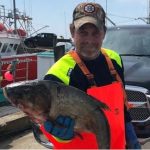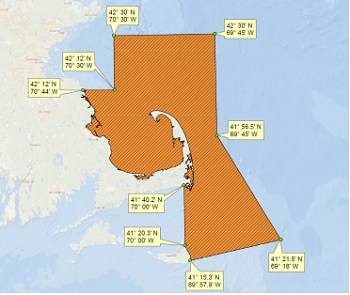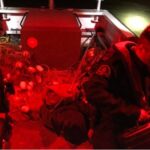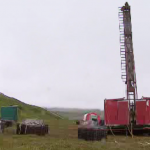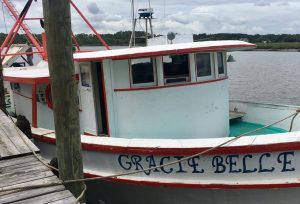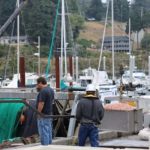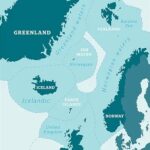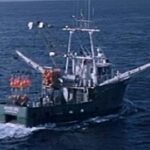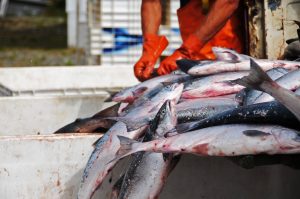Monthly Archives: February 2017
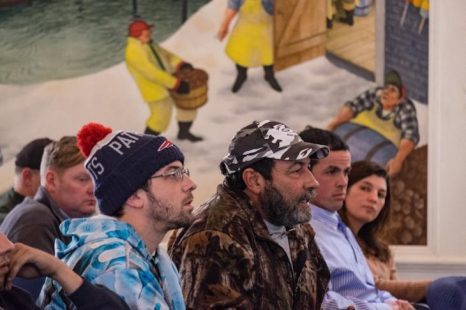
Vineyard Fishermen Warn of Ruin If Conch Rule Enacted
Martha’s Vineyard commercial fishermen spent more than two and a half hours Wednesday letting the state’s Division of Marine Fisheries know what they think of 18 proposed rule updates and new regulations. Some of the changes are minor tweaks to clarify existing rules, but others, if enacted, would affect the Vineyard’s fishing industry more significantly. Island speakers vehemently opposed a draft proposal to increase the minimum size of knobbed and channeled whelk, generally called conch, by three sixteenths of an inch in 2017. “That is a horrifying number,” said Tom Turner, a longtime Edgartown fisherman. “You’re guaranteeing the death of a fishery, and that would happen within two years of a three-sixteenth increase.” Continue reading the story here 15:16
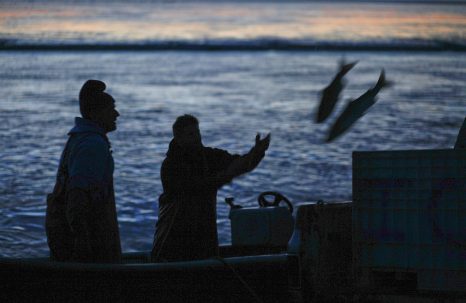
Rebuttal: The actual, factual new realities of Cook Inlet salmon – Catherine Cassidy of Kasilof
In his opinion piece published in the Alaska Journal of Commerce on Feb. 8, (Click here to read it) Mr. Karl Johnstone, presumably from his home in Arizona, gave a eulogy at the graveside of Cook Inlet commercial salmon fishing. Actually, the industry is alive and well and helping Alaskans get through these economic hard times. Mr. Johnstone uses the same old tired, outdated arguments: there is not enough salmon in Cook Inlet for all users; Cook Inlet salmon can’t compete with farmed salmon, sportfisheries are so much more valuable than commercial fisheries; etc. He cites an economic report about angler spending that was conducted prior to the national recession in 2008 and the recent king salmon decline and compares the numbers to the very lowest possible measure of commercial harvest value in Cook Inlet on a bad year. Johnstone claims that Alaska salmon can’t compete with farmed salmon. Twenty years ago that was a problem but the industry adapted and now wild Alaska salmon have a solid market niche and Cook Inlet sockeye is a very premium, sought-after product in America. The worst economic lie that he and his pals have been promoting is that the sport industry and personal use fisheries could actually grow large enough to replace the value of the commercial industry to our state. Then, she pins him. Continue reading the op-ed here 13:46
Fishermen skeptical of third environmental monitoring device in the Minas Passage
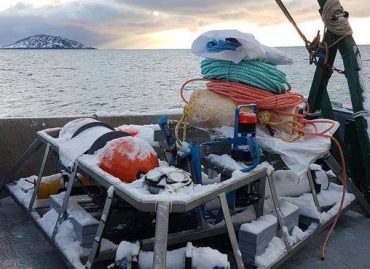 A third environmental monitoring platform is being tested in the Minas Passage by the Fundy Ocean Research Centre for Energy, or FORCE, but a fishermen’s group maintains the sophisticated equipment being deployed still cannot determine mortality, the ultimate environmental test on marine life in the Bay of Fundy. FAST-3 is a third monitoring platform featuring additional sensors to collect data on fish presence and behaviour that was deployed on Feb 2. Several marine industrial companies around the province contributed to its construction and deployment. The platform isn’t on the actual turbine site but in a 10-metre shallower area adjacent to the Crown-lease area that the Province of Nova Scotia has designated for testing up to five different turbine technologies in the near future. Dr. Haley Viehman, a post-doctoral fellow at Acadia University, will be analyzing the data upon its retrieval within a month. Viehman comes to the province from the University of Maine, where she studied fish interactions for five years using hydro-acoustics to observe fish movements prior, during and after a tidal turbine was deployed in 2012 for a year as a test in Cobscook Bay, Maine. Continue reading the story here 12:31
A third environmental monitoring platform is being tested in the Minas Passage by the Fundy Ocean Research Centre for Energy, or FORCE, but a fishermen’s group maintains the sophisticated equipment being deployed still cannot determine mortality, the ultimate environmental test on marine life in the Bay of Fundy. FAST-3 is a third monitoring platform featuring additional sensors to collect data on fish presence and behaviour that was deployed on Feb 2. Several marine industrial companies around the province contributed to its construction and deployment. The platform isn’t on the actual turbine site but in a 10-metre shallower area adjacent to the Crown-lease area that the Province of Nova Scotia has designated for testing up to five different turbine technologies in the near future. Dr. Haley Viehman, a post-doctoral fellow at Acadia University, will be analyzing the data upon its retrieval within a month. Viehman comes to the province from the University of Maine, where she studied fish interactions for five years using hydro-acoustics to observe fish movements prior, during and after a tidal turbine was deployed in 2012 for a year as a test in Cobscook Bay, Maine. Continue reading the story here 12:31
Lawsuit over fisheries observers to reach Court of Appeals in March
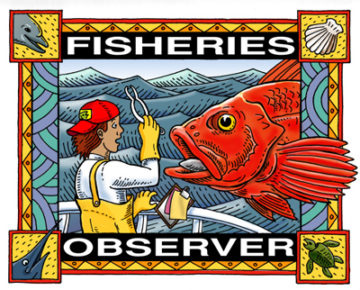 A New England fishermen’s group suing the federal government over the cost of at-sea monitoring is scheduled to present oral arguments before the federal Court of Appeals in March. The government shifted the cost of paying for monitors to fishermen last year. A group led by New Hampshire fisherman David Goethel sued the government over the rule change. The fishermen lost in federal district court and appealed. Attorneys say the arguments are set to take place March 7. Monitors can cost hundreds of dollars per day. Fishermen argue it represents an illegal new cost burden they can’t shoulder in an era of tight quotas. The rules apply to fishermen of species such as cod and sole. link 11:16
A New England fishermen’s group suing the federal government over the cost of at-sea monitoring is scheduled to present oral arguments before the federal Court of Appeals in March. The government shifted the cost of paying for monitors to fishermen last year. A group led by New Hampshire fisherman David Goethel sued the government over the rule change. The fishermen lost in federal district court and appealed. Attorneys say the arguments are set to take place March 7. Monitors can cost hundreds of dollars per day. Fishermen argue it represents an illegal new cost burden they can’t shoulder in an era of tight quotas. The rules apply to fishermen of species such as cod and sole. link 11:16
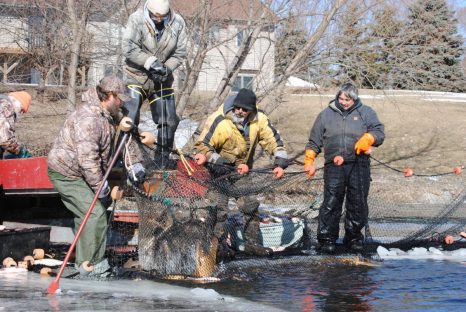
Commercial ice fishermen in Rice County Minnesota remove carp by the truckload
February fishing in Faribault is nothing new. Ice fishing houses routinely dot Rice County’s lakes in this frigid month as intrepid outdoorsmen continue their Minnesotan search for the perfect fish. Unusual in this deeply-rooted ice fishing culture is a semi-truck, left idling next to Cannon Lake in the parking lot of Shager Park outside Faribault. On its side, the trailer reads simply, “FISH,” which is all one needs to know about the contents of its load. While Faribault’s anglers are surely prolific with a line and a lure, nobody who takes their pickup on Cannon Lake on a Friday afternoon could fill this semi. Bruce Geyer, a commercial fisherman from Waterville, can. On Friday, Geyer took away an enormous load of carp, sheepshead and ictiobus, which are more commonly known as buffalo. Earlier in the week, Geyer lifted 20,000 pounds of carp, 5,000 pounds of sheepshead and nearly 500 pounds of buffalo. On Friday, he estimated that the day’s load dwarfed that of earlier in the week. Photos, continue reading the story here 10:16
Hollywood to begin filming new Coast Guard movie that no one will watch
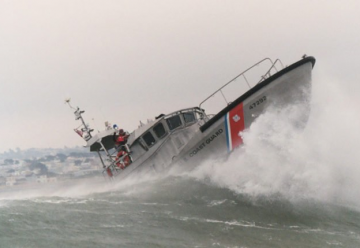 A new action-thriller movie based on true experiences from a search-and-rescue unit is set to be the next Coast Guard movie that no one will actually watch, sources confirmed today. “The Impossible Rescue” stars actor Tom Hardy, whose acting credits include “Inception” and “Mad Max: Fury Road.” Sources say Hardy will be the main protagonist whose rescue efforts saved a bunch of people or whatever. Though the sources added that, what’s the point anyway since nobody will see a Coast Guard movie no matter who the fuck is in it. With Ashton Kutcher and Chris Pine already sporting lead roles in Coast Guard films and supporting roles with Kevin Costner and Casey Affleck, star power seems to have zero effect on audience draw, the sources said. Sources say the film’s cast will also include a generic white woman who will be a two-dimensional love interest, an up-and-coming young actor from some TV show you’ve never watched, while an aging actor that you’ve seen in a bunch of movies but can’t remember his goddamn name will play the unit’s commanding officer. Read the story here 09:41
A new action-thriller movie based on true experiences from a search-and-rescue unit is set to be the next Coast Guard movie that no one will actually watch, sources confirmed today. “The Impossible Rescue” stars actor Tom Hardy, whose acting credits include “Inception” and “Mad Max: Fury Road.” Sources say Hardy will be the main protagonist whose rescue efforts saved a bunch of people or whatever. Though the sources added that, what’s the point anyway since nobody will see a Coast Guard movie no matter who the fuck is in it. With Ashton Kutcher and Chris Pine already sporting lead roles in Coast Guard films and supporting roles with Kevin Costner and Casey Affleck, star power seems to have zero effect on audience draw, the sources said. Sources say the film’s cast will also include a generic white woman who will be a two-dimensional love interest, an up-and-coming young actor from some TV show you’ve never watched, while an aging actor that you’ve seen in a bunch of movies but can’t remember his goddamn name will play the unit’s commanding officer. Read the story here 09:41
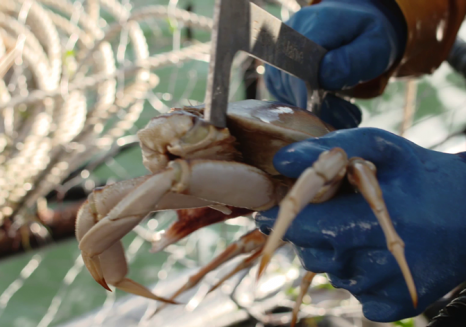
In Seaside, Oregon, youngsters are learning about crabs in ‘Boat to School’
Commercial Dungeness crab season is red-hot and rolling despite cold and wet conditions. Dean Ellsworth says his 44-foot fishing boat, the “Nola K,” is his winter home at this time of year. Ellsworth and his three-man crew spend long days and nights tossing out and pulling in nearly a thousand 80-pound crab pots during a fishing season that’s hitting its stride.,, This year, fishermen say Oregon seafood is so important to the state that it’s time to take the message to school. In Seaside, Oregon youngsters are learning valuable lessons about Oregon’s famous seafood. The program is called “Boat to School,” and it’s a pilot project that brings together educators, their students and fishermen who show and tell the fifth graders at Seaside’s Heights Elementary School where their food comes from. Photo gallery, read the story here 08:47
Fisherman rescued after falling into water at Fishermen’s Terminal
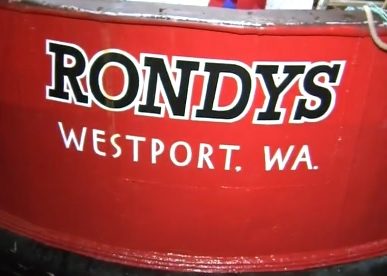 A man was taken to the hospital after he was pulled from the water at Seattle’s Fishermen’s Terminal Friday night. Seattle fire officials said the man was walking off a vessel on a makeshift plank and fell, when the plank broke. Israel Bynum, a crew member on the vessel named Rondys, said he had just crossed the plank 30 seconds before his boss did. “I was looking at him, and I heard the board break, and I went to try to support it and there was no support. He just went,” Bynum said. Bynum said his captain, Mark Sehlbach, has been on the TV show ‘Deadliest Catch.” Sehlbach was pulled out of the water and taken to Harborview Medical Center. Later in the evening, Bynum said Sehlbach was discharged from the hospital with a bruised rib. The crew had just returned Thursday from a trip to Alaska. Watch the video, read the story here 08:02
A man was taken to the hospital after he was pulled from the water at Seattle’s Fishermen’s Terminal Friday night. Seattle fire officials said the man was walking off a vessel on a makeshift plank and fell, when the plank broke. Israel Bynum, a crew member on the vessel named Rondys, said he had just crossed the plank 30 seconds before his boss did. “I was looking at him, and I heard the board break, and I went to try to support it and there was no support. He just went,” Bynum said. Bynum said his captain, Mark Sehlbach, has been on the TV show ‘Deadliest Catch.” Sehlbach was pulled out of the water and taken to Harborview Medical Center. Later in the evening, Bynum said Sehlbach was discharged from the hospital with a bruised rib. The crew had just returned Thursday from a trip to Alaska. Watch the video, read the story here 08:02
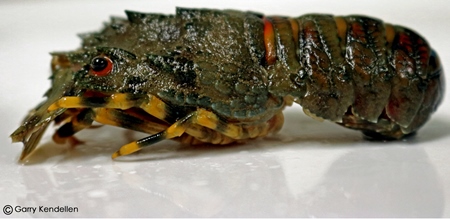
Skipper knew he came across something special when he landed this rare and exotic Slipper Lobster
The extremely rare Slipper Lobster was found recently off Ros a Mhil near the Aran Islands and is now being cared for by Galway Atlantaquaria. This is the first recorded landing of this species this far into the Atlantic north. Slipper Lobsters are bottom dwelling creatures usually found throughout the Mediterranean. Over the last decade there has been a couple of reports of the species being caught off Kerry and a pregnant Slipper lobster was landed off Cork in 2007. Skipper John Connolly of the ‘Connacht Ranger’ from Kilronan on Inis Mor, and landed this exotic catch off Ros a Mhil. The Skipper knew he had landed something rare and so he contacted the Marine Institute to report his find. Read the story here 14:44
Northumberland Fishermen’s Association wants carapace size increase
 For over two years, the local Northumberland Fishermen’s Association has been wanting an increase in lobster carapace size from the Minister of Fisheries and for two years they’ve waited for an answer. “They’re dragging their feet,” says Northumberland’s Fishermen’s Association President Ron Heighton. In early 2015, the association met with Fisheries and Oceans and other fishing organizations to discuss and agree to potential changes to the lobster industry in order to increase the carapace lobster size within a two-year window. At that time, after a ballot vote was distributed among all the lobster fishers in lobster fishing area 26A in Nova Scotia with the majority voting for an increase in carapace size. The carapace is the part of the body between the lobster’s eyes and its tail. Fishermen who catch undersized lobster have to throw them back. Two years later, there has been no decision reached by Fisheries and Oceans about implementing a size increase for the upcoming lobster season, Heighton said. Read the story here 14:23
For over two years, the local Northumberland Fishermen’s Association has been wanting an increase in lobster carapace size from the Minister of Fisheries and for two years they’ve waited for an answer. “They’re dragging their feet,” says Northumberland’s Fishermen’s Association President Ron Heighton. In early 2015, the association met with Fisheries and Oceans and other fishing organizations to discuss and agree to potential changes to the lobster industry in order to increase the carapace lobster size within a two-year window. At that time, after a ballot vote was distributed among all the lobster fishers in lobster fishing area 26A in Nova Scotia with the majority voting for an increase in carapace size. The carapace is the part of the body between the lobster’s eyes and its tail. Fishermen who catch undersized lobster have to throw them back. Two years later, there has been no decision reached by Fisheries and Oceans about implementing a size increase for the upcoming lobster season, Heighton said. Read the story here 14:23
Don Young hits term limit for House subcommittee chairmanship
 Alaska’s sole congressman, Don Young, will not chair any committees or subcommittees during this term of Congress, having reached term limits in all of his prior positions. Young will retain some leadership positions and remains the longest-serving Republican in the House. Since 1994, Republicans in the House and Senate have imposed six-year term limits on committee leadership. Instead, this year Young was named “chairman emeritus” of the Committee on Natural Resources. The position allows him to sit on all five subcommittees, which oversee federal lands and the resources located on them, oceans, Native affairs and related investigations. Read the story here 13:05
Alaska’s sole congressman, Don Young, will not chair any committees or subcommittees during this term of Congress, having reached term limits in all of his prior positions. Young will retain some leadership positions and remains the longest-serving Republican in the House. Since 1994, Republicans in the House and Senate have imposed six-year term limits on committee leadership. Instead, this year Young was named “chairman emeritus” of the Committee on Natural Resources. The position allows him to sit on all five subcommittees, which oversee federal lands and the resources located on them, oceans, Native affairs and related investigations. Read the story here 13:05
Southeast’s first crab fisheries of the year set to open
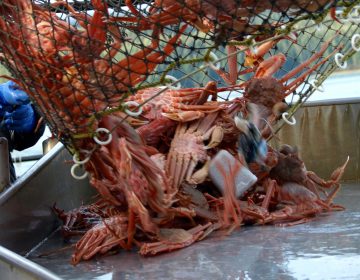 Alaska has dozens of crab species—about seven that are commercial harvested. So what’s Tanner crab like? To help answer that question, I asked Joe Stratman, the lead crab biologist for the Alaska Department of Fish and Game in Southeast. He says Tanners are related to the popular snow crab. “What I always liken it to is when they’re at the buffet line in Los Vegas they often see snow crab which is a kind of Chionoecetes opilio. Our Tanner crab in Southeast looks very similar to that. It’s a little larger,” Stratman said. Recent markets seem to like Tanner crab too. Last year’s harvest in Southeast was valued at nearly $3 million dollars. 74 permit holders participated in the fishery. They brought in a total of just over 1.3 million pounds. The price per pound averaged $2.23 which is thirty cents higher than the year before. Read the story here 11:54
Alaska has dozens of crab species—about seven that are commercial harvested. So what’s Tanner crab like? To help answer that question, I asked Joe Stratman, the lead crab biologist for the Alaska Department of Fish and Game in Southeast. He says Tanners are related to the popular snow crab. “What I always liken it to is when they’re at the buffet line in Los Vegas they often see snow crab which is a kind of Chionoecetes opilio. Our Tanner crab in Southeast looks very similar to that. It’s a little larger,” Stratman said. Recent markets seem to like Tanner crab too. Last year’s harvest in Southeast was valued at nearly $3 million dollars. 74 permit holders participated in the fishery. They brought in a total of just over 1.3 million pounds. The price per pound averaged $2.23 which is thirty cents higher than the year before. Read the story here 11:54
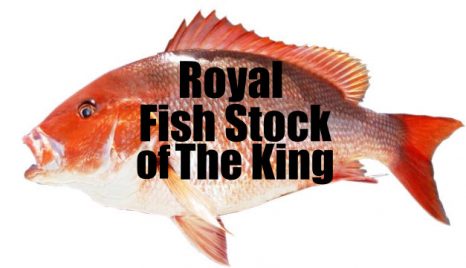
Hooked Up!!! Sea lords and the secret votes that made them rich
The votes helped create the system that now allows 50 businesses and fishermen to control 81 percent of the nation’s commercial red snapper allocation. Those fishermen can make a total of $23 million every year. And the government gets nothing in return from the fishermen. “This is a public asset,” Congressman Garret Graves says. “You and I own this. The public owns this. You know, people always talk about [how] government needs to run like a business. Could you ever imagine a business saying, ‘Oh, here’s our inventory, and it’s free! You come in a grocery store, you take whatever you want.’ The vote predates Graves’ term in Washington. But last decade, Congress helped orchestrate it. The feds wanted to start what’s called an IFQ program, short for “individual fishing quota”. Fishermen would get an allocation to fish the entire year. Congress required three votes – first by a little-known public body called the Gulf of Mexico Fisheries Management Council, an 11-member body that’s primarily appointed by the five Gulf states. After the Gulf Council vote, Congress also required two votes by the commercial fishermen who already were permitted to fish for red snapper in the Gulf. And those are the votes that the federal government won’t let us see. Video, read the story here 11:09
Massachusetts fisheries officials: Loophole in striped bass fishery needs closing
 Massachusetts fisheries officials want to to close a loophole in state regulations that resulted in what they believe were illegal landings of striped bass last year. At a public hearing at Massachusetts Maritime Academy Wednesday night, Division of Marine Fisheries Deputy Director Dan McKiernan said the state is looking to reduce the number of striped bass that commercial fishermen could land from 15 down to two, if they’re fishing from shore. “What happened last year was disgusting,” said Patrick Paquette of the Massachusetts Striped Bass Association, which is composed of both commercial and recreational fishermen. “There was a rampant black market at the (Cape Cod) canal. Plenty of guys were taking fish from friends, putting them in coolers, and selling them under their boat permit.” Under state striped bass fishing regulations, a commercial fisherman can buy a boat permit that allows him or her to catch and sell up to 15 fish a day. There is also a less expensive individual permit under which he or she can land two fish a day from shore. The state limited commercial fishing to two days a week. In bad weather, some fishermen with boat permits fished from shore, and could technically land their 15 fish. Read the story here 09:37
Massachusetts fisheries officials want to to close a loophole in state regulations that resulted in what they believe were illegal landings of striped bass last year. At a public hearing at Massachusetts Maritime Academy Wednesday night, Division of Marine Fisheries Deputy Director Dan McKiernan said the state is looking to reduce the number of striped bass that commercial fishermen could land from 15 down to two, if they’re fishing from shore. “What happened last year was disgusting,” said Patrick Paquette of the Massachusetts Striped Bass Association, which is composed of both commercial and recreational fishermen. “There was a rampant black market at the (Cape Cod) canal. Plenty of guys were taking fish from friends, putting them in coolers, and selling them under their boat permit.” Under state striped bass fishing regulations, a commercial fisherman can buy a boat permit that allows him or her to catch and sell up to 15 fish a day. There is also a less expensive individual permit under which he or she can land two fish a day from shore. The state limited commercial fishing to two days a week. In bad weather, some fishermen with boat permits fished from shore, and could technically land their 15 fish. Read the story here 09:37
The perils of approving a marine sanctuary
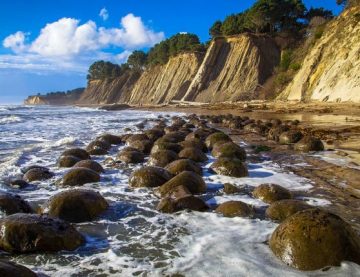 The word sanctuary has a nice sound. A holy place or natural retreat for animals. Add marine. Marine sanctuary. A safe place for Dory. Add Native Americans. It’s a trifecta: Chumash Heritage National Marine Sanctuary. Sounds so beautiful. Or is it? Our San Luis Obispo County Board of Supervisors has had two hearings on this subject in recent weeks. Other cities and agencies have also been hearing this proposal. But, the Board of Supervisors voted 3-2 against the establishment of a sanctuary off our coast. How can this be? Proponents for the sanctuary delivered 12,000 signatures on petitions to demonstrate local support. On the other side, the opponents appeared to have fewer than 400 supporters. On one hand, thousands of local citizen have faced off against the small business community as represented by commercial fishermen, ranchers, farmers and the Chamber of Commerce. An analogy may be that this is a case of popular vote versus the Electoral College as we saw in the recent presidential election. Another wrinkle is the name of the sanctuary. Although “Chumash” is used in the title, the only state and federally recognized Chumash Tribe, the Santa Ynez Band of Chumash Indians has not endorsed the sanctuary bearing their name. Another state recognized tribe, The Salinan Tribe, has not endorsed the sanctuary either. What’s going on? Great read! Read the story here 08:56
The word sanctuary has a nice sound. A holy place or natural retreat for animals. Add marine. Marine sanctuary. A safe place for Dory. Add Native Americans. It’s a trifecta: Chumash Heritage National Marine Sanctuary. Sounds so beautiful. Or is it? Our San Luis Obispo County Board of Supervisors has had two hearings on this subject in recent weeks. Other cities and agencies have also been hearing this proposal. But, the Board of Supervisors voted 3-2 against the establishment of a sanctuary off our coast. How can this be? Proponents for the sanctuary delivered 12,000 signatures on petitions to demonstrate local support. On the other side, the opponents appeared to have fewer than 400 supporters. On one hand, thousands of local citizen have faced off against the small business community as represented by commercial fishermen, ranchers, farmers and the Chamber of Commerce. An analogy may be that this is a case of popular vote versus the Electoral College as we saw in the recent presidential election. Another wrinkle is the name of the sanctuary. Although “Chumash” is used in the title, the only state and federally recognized Chumash Tribe, the Santa Ynez Band of Chumash Indians has not endorsed the sanctuary bearing their name. Another state recognized tribe, The Salinan Tribe, has not endorsed the sanctuary either. What’s going on? Great read! Read the story here 08:56
Open Letter to George Soros, Help Us Kill Industrial Fishing
 Dear Mr. Soros: The Global High Seas Marine Preserve, when established, will effectively ban industrial and commercial fishing in international waters and thus allow stocks of major marine predators and other species to return in numbers sufficient to permit “some” fishing. My name is Danny Quintana and I conceived of the idea of the GHSMP when writing my latest book, Space & Ocean Exploration: The Alternative to the Military-Industrial Complex. During research for the book I realized how dire the situation of ocean wildlife had become in the last 50 years during a technological boom in the fishing industry and the sushi craze which is still in full swing throughout much of the world. Read the rest here (if you can stand it!) 08:30
Dear Mr. Soros: The Global High Seas Marine Preserve, when established, will effectively ban industrial and commercial fishing in international waters and thus allow stocks of major marine predators and other species to return in numbers sufficient to permit “some” fishing. My name is Danny Quintana and I conceived of the idea of the GHSMP when writing my latest book, Space & Ocean Exploration: The Alternative to the Military-Industrial Complex. During research for the book I realized how dire the situation of ocean wildlife had become in the last 50 years during a technological boom in the fishing industry and the sushi craze which is still in full swing throughout much of the world. Read the rest here (if you can stand it!) 08:30
Fishing Industry Fights N.Y. Offshore Wind Area In Court
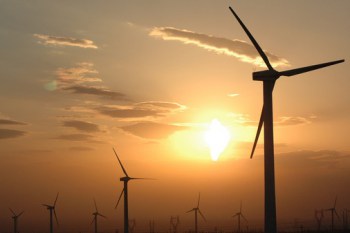 Lawyers representing a host of fishing communities, associations and businesses – led by scallop industry trade group the Fisheries Survival Fund – argued in U.S. District Court in Washington, D.C., yesterday against an offshore wind lease sale off the coast of Long Island, N.Y. A ruling is expected in the coming days, according to a press release from the Fisheries Survival Fund. The plaintiffs are seeking a preliminary injunction against the wind farm lease that the U.S. Bureau of Ocean Energy Management (BOEM) preliminarily awarded to Statoil for $42.5 million at an auction in December. They argued that the site of the project is in the middle of important fishing grounds, particularly for the scallop and squid fisheries. They also claimed that allowing the “unlawful” lease sale to go through would cause “irreparable harm to commercial fishermen.” Read the story here 07:31
Lawyers representing a host of fishing communities, associations and businesses – led by scallop industry trade group the Fisheries Survival Fund – argued in U.S. District Court in Washington, D.C., yesterday against an offshore wind lease sale off the coast of Long Island, N.Y. A ruling is expected in the coming days, according to a press release from the Fisheries Survival Fund. The plaintiffs are seeking a preliminary injunction against the wind farm lease that the U.S. Bureau of Ocean Energy Management (BOEM) preliminarily awarded to Statoil for $42.5 million at an auction in December. They argued that the site of the project is in the middle of important fishing grounds, particularly for the scallop and squid fisheries. They also claimed that allowing the “unlawful” lease sale to go through would cause “irreparable harm to commercial fishermen.” Read the story here 07:31
North Pacific Fishery Management Council gets review of Bering Sea pollock program
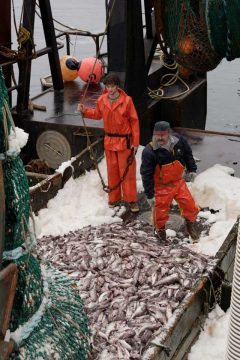 After two years of almost ceaseless contention, the North Pacific regulatory waters have cooled down for now. The Council oversees all federal fisheries between three and 200 miles off the Alaska coast. One of eight regions, the North Pacific fishery is by far the country’s most profitable, having produced two-thirds of the country’s total seafood value in 2015. Over the last two years, the council has been in battle mode over chinook salmon and halibut bycatch, and Gulf of Alaska groundfish catch shares. There have been parades of protest and industry stand-downs and rural Alaska villages emptied to give impassioned pleas alongside Seattle fishing crews and captains. At the council’s Seattle meeting Feb. 1-6, the council rested for the most part, taking scant public comment and few final actions. Rather, it focused on some of the structures behind the chaos, reviewing catch share programs and looking for areas to tune up following two years of pushing the gas. After indefinitely tabling a Gulf of Alaska catch share system four years in the works at its meeting this past December, the council reviewed the schematics behind the Bering Sea pollock fishery, Alaska’s largest fishery by volume. Read the rest of the article here 20:36
After two years of almost ceaseless contention, the North Pacific regulatory waters have cooled down for now. The Council oversees all federal fisheries between three and 200 miles off the Alaska coast. One of eight regions, the North Pacific fishery is by far the country’s most profitable, having produced two-thirds of the country’s total seafood value in 2015. Over the last two years, the council has been in battle mode over chinook salmon and halibut bycatch, and Gulf of Alaska groundfish catch shares. There have been parades of protest and industry stand-downs and rural Alaska villages emptied to give impassioned pleas alongside Seattle fishing crews and captains. At the council’s Seattle meeting Feb. 1-6, the council rested for the most part, taking scant public comment and few final actions. Rather, it focused on some of the structures behind the chaos, reviewing catch share programs and looking for areas to tune up following two years of pushing the gas. After indefinitely tabling a Gulf of Alaska catch share system four years in the works at its meeting this past December, the council reviewed the schematics behind the Bering Sea pollock fishery, Alaska’s largest fishery by volume. Read the rest of the article here 20:36
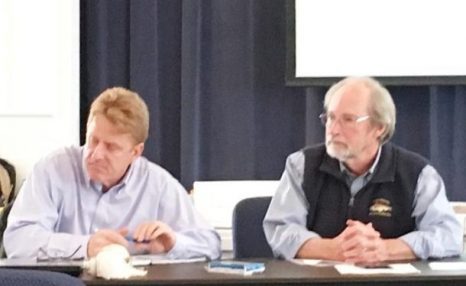
Mass DMF gets an earful from conch fishermen, David Pierce mentions squid trawling
Officials from the Division of Marine Fisheries on their annual rounds to inform fishermen of proposed regulations for 2017 held a public hearing at the Katharine Cornell Theater in Tisbury on Wednesday morning. A lengthy agenda cast a wide net on changes in proposed limits to finfish and shellfish, but the most spirited debate by far was over a proposed increase to the minimum size of channel whelk and knob whelk, often referred to as “conch,” for this year. DMF director David Pierce and deputy director Dan McKiernan moderated the discussion. Local fishermen portended dire economic circumstances if the current minimum size, measured at the shell’s widest point, is increased from 3 inches to 3 3⁄16 inches. DMF officials countered that without the increase, the future of the conch fishery, the most valuable fishery on Martha’s Vineyard, will be in serious jeopardy in a matter of years. Prior to the start of the public hearing, DMF director David Pierce said that while on vacation on Martha’s Vineyard last year, he picked up a copy of The MV Times and read the Sept. 7 story, “Squid trawlers leave a wake of death south of Martha’s Vineyard” that described the miles of dead by-catch — mostly squid and scup — left behind by squid trawlers operating just outside the three-mile state limit south of Martha’s Vineyard. Read the story here 17:04
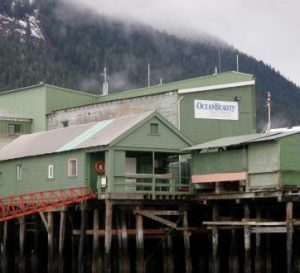
Ocean Beauty won’t can salmon in Petersburg in 2017
Petersburg will only have one salmon cannery operating this summer. Ocean Beauty Seafoods will not be canning fish at the company’s plant in Petersburg in 2017. Tom Sunderland, vice president of marketing, says current market conditions favor selling frozen salmon over canned. “We’re gonna make a lot more money selling frozen salmon than canned salmon this year and the Petersburg plant is essentially a cannery,” Sunderland explained. “It doesn’t have a very large or efficient freezing operation, certainly not enough that you could run it just as a freezing operation. Our plant at Excursion Inlet on the other hand does have substantial freezing capacity and we can move that production over there and take care of that. And by doing so, the hope is we can return the highest value to the fleet by putting the product into its most lucrative product form.” Read the rest here 12:40
Maine lawmaker proposes ban on wind turbines near Monhegan
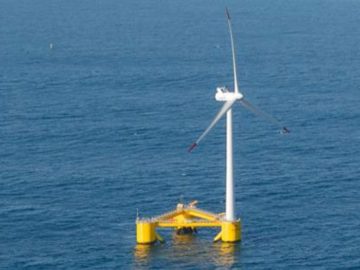 Sen. Dana Dow, R-Damariscotta, wants to prohibit a wind energy test area within 10 miles of the island’s lobster conservation area. The current site is roughly 2 1/2 miles off the island. Through the Senate Republican Office, Dow issued a statement saying the project would threaten migrating birds as well as the remote, rugged beauty that draws artists and tourists. He said Mainers wouldn’t allow such a project near Mount Katahdin or Acadia National Park, which, like Monhegan, are special places. Dow’s bill reflects similar positions voiced by a group of year-round and seasonal residents and their supporters called Protect Monhegan. Other residents, however, say they support the project, but want to negotiate the best deal for the community. Read the story here 11:29
Sen. Dana Dow, R-Damariscotta, wants to prohibit a wind energy test area within 10 miles of the island’s lobster conservation area. The current site is roughly 2 1/2 miles off the island. Through the Senate Republican Office, Dow issued a statement saying the project would threaten migrating birds as well as the remote, rugged beauty that draws artists and tourists. He said Mainers wouldn’t allow such a project near Mount Katahdin or Acadia National Park, which, like Monhegan, are special places. Dow’s bill reflects similar positions voiced by a group of year-round and seasonal residents and their supporters called Protect Monhegan. Other residents, however, say they support the project, but want to negotiate the best deal for the community. Read the story here 11:29
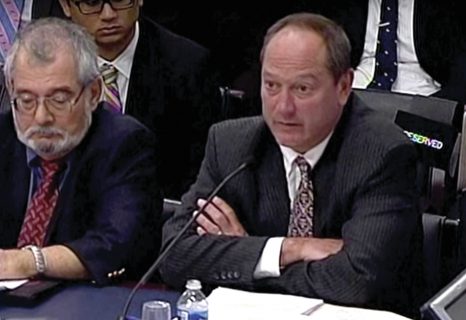
North Pacific council director a possibility for Assistant Administrator position at NMFS replacing Eileen Sobeck
Chris Oliver, the executive director of the North Pacific Fishery Management Council for the past 16 years, didn’t ask for a consideration as the new assistant administrator for the National Marine Fisheries Service; rather, the most powerful fishing industry voices in the nation’s most profitable region asked. He doesn’t know if the new administration will offer it or if he’d want it if it did. Still, looking at his history, knowledge and reputation, he seems in many ways a natural fit. Oliver said when it became known that the current administrator, Eileen Sobeck, won’t be staying with the new administration, parts of the fishing universe aligned. In the North Pacific and elsewhere, catch share systems are a contentious issue; Oliver said in an interview he’s already had fisheries stakeholders from other regions probing for what his intent would be with their respective fisheries. Oliver’s answer sums up both his attitude and in part that of the new administration. “It’s not my call,” he said. “What makes sense in the North Pacific…may not make sense in New England, or in the Gulf of Mexico. Read the story here 10:47
Chronic labour shortage hobbling Meteghan lobster plant
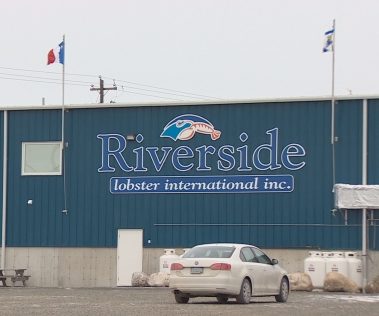 David Deveau is doing everything he can to find and keep local workers for his modern lobster processing plant in western Nova Scotia, but it is a battle he is losing. “We do have great local people here. I love them all. I respect them all,” said Deveau, CEO of Riverside Lobster International in the Meteghan area. “I don’t have enough. I just don’t have enough.” Deveau’s company now operates five buses daily to bring workers in from Digby and Yarmouth. Workers are paid about $13 per hour and enrolled in a defined contribution pension plan and get health benefits. The plant, which employs 300 people processing 27,000 kilograms a day of fresh and frozen lobster, is chronically short between 20 to 30 workers. Read the story here 09:52
David Deveau is doing everything he can to find and keep local workers for his modern lobster processing plant in western Nova Scotia, but it is a battle he is losing. “We do have great local people here. I love them all. I respect them all,” said Deveau, CEO of Riverside Lobster International in the Meteghan area. “I don’t have enough. I just don’t have enough.” Deveau’s company now operates five buses daily to bring workers in from Digby and Yarmouth. Workers are paid about $13 per hour and enrolled in a defined contribution pension plan and get health benefits. The plant, which employs 300 people processing 27,000 kilograms a day of fresh and frozen lobster, is chronically short between 20 to 30 workers. Read the story here 09:52
Decision on preliminary injunction on offshore sale in ‘coming days’
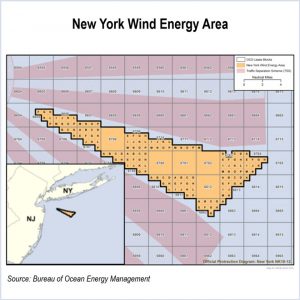 A US court is expected to issue a ruling in the coming days on a lawsuit seeking a preliminary injunction against the development of the up to 1GW New York offshore wind farm lease area. The Fisheries Survival Fund (FSF), which represents the majority of the limited access Atlantic scallop fleet, is the lead plaintiff in the lawsuit that alleges the Bureau of Ocean Energy Management (BOEM) leasing process did not adequately consider the impact of wind power development on the region’s fishermen. The plaintiffs, which also include the Garden State Seafood Association and the Long Island Commercial Fishing Association, argue that allowing the lease sale to go through would cause irreparable harm to commercial fishermen. Norwegian oil major Statoil won the December auction for the right to develop the 32,000-hectare site off the coast of Long Island with a bid of $42.5m. BOEM has delayed execution of the lease until the court has ruled on the preliminary injunction. Link 09:33
A US court is expected to issue a ruling in the coming days on a lawsuit seeking a preliminary injunction against the development of the up to 1GW New York offshore wind farm lease area. The Fisheries Survival Fund (FSF), which represents the majority of the limited access Atlantic scallop fleet, is the lead plaintiff in the lawsuit that alleges the Bureau of Ocean Energy Management (BOEM) leasing process did not adequately consider the impact of wind power development on the region’s fishermen. The plaintiffs, which also include the Garden State Seafood Association and the Long Island Commercial Fishing Association, argue that allowing the lease sale to go through would cause irreparable harm to commercial fishermen. Norwegian oil major Statoil won the December auction for the right to develop the 32,000-hectare site off the coast of Long Island with a bid of $42.5m. BOEM has delayed execution of the lease until the court has ruled on the preliminary injunction. Link 09:33
Gillnetter heeds siren call of the river – Fishing, family, community. That’s Crouse’s melody.
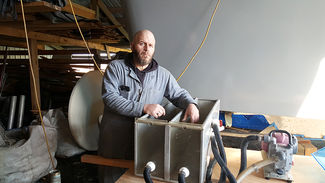 Crouse didn’t come from a fishing family but he grew up in a neighborhood of fishermen in Skamokawa. “For as long as I can remember I wanted to fish the river,” Crouse said. “In kindergarten they had us make plates out of clay and I drew a gillnet boat on mine.” When he was 14, he asked his basketball coach, Bill Olsen if he could work for him on the river. At 15, he went to Alaska to fish during the summer. “Paul Dretsch worked in a cannery up there and he told me to work there until I found a job on a boat,” Crouse said. “There is a radio station in the Bristol Bay area, and every three hours job listings came up. After my second shift in the cannery, I called someone who was advertising for boat board fish picker. That was my first job up there.” It was everything he wanted and it was more difficult than he had imagined. In his mid-40s now, Crouse works at Wauna four days a week and waits to hear when he can get back out on the river. He rebuilds boats and buys outfits from retiring fishermen when he can. He’ll take what he needs and part and parcel out the rest to sell. His wife, Erla, drives a school bus and works at her coffee shop in Cathlamet, Waterway Espresso. Read the story here 09:16
Crouse didn’t come from a fishing family but he grew up in a neighborhood of fishermen in Skamokawa. “For as long as I can remember I wanted to fish the river,” Crouse said. “In kindergarten they had us make plates out of clay and I drew a gillnet boat on mine.” When he was 14, he asked his basketball coach, Bill Olsen if he could work for him on the river. At 15, he went to Alaska to fish during the summer. “Paul Dretsch worked in a cannery up there and he told me to work there until I found a job on a boat,” Crouse said. “There is a radio station in the Bristol Bay area, and every three hours job listings came up. After my second shift in the cannery, I called someone who was advertising for boat board fish picker. That was my first job up there.” It was everything he wanted and it was more difficult than he had imagined. In his mid-40s now, Crouse works at Wauna four days a week and waits to hear when he can get back out on the river. He rebuilds boats and buys outfits from retiring fishermen when he can. He’ll take what he needs and part and parcel out the rest to sell. His wife, Erla, drives a school bus and works at her coffee shop in Cathlamet, Waterway Espresso. Read the story here 09:16
Hooked Up!!! Catch Share Politics – ‘Sea Lords’ hook a congressional reformer
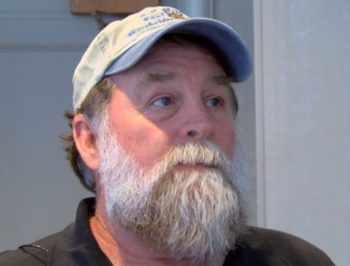 Steve Southerland agrees: He was something of a threat to some commercial fishermen. The former Florida congressman led the effort to change a federal program (catch shares) – unknown to most taxpayers – that allows a handful of businesses and fishermen to make millions off a government resource, creating what some fisherman call “lords of the sea.” The government essentially decides who will be a successful commercial fisherman and who will not.” And it doesn’t matter how hard you work,” Southerland says. “It doesn’t matter, you know, how much money you have to… That you’ve borrowed. It’s all based on a philosophy. And if you believed in that philosophy, then you win.” Southerland took to the floor of Congress, trying to make changes. In response, the same commercial fishermen profiting off this government resource poured tens of thousands of dollars into the campaign account of Southerland’s congressional opponent. Those same fishermen contributed additional money to a political action committee called Ocean Champions that also went after Southerland. “I think that it was a group of fishermen that worked towards that,” says Galveston, Texas commercial fisherman Buddy Guindon. “Mostly guys out of Florida. I didn’t have much to do with it. I contributed a little money to them.” Video, Read the story here 08:25
Steve Southerland agrees: He was something of a threat to some commercial fishermen. The former Florida congressman led the effort to change a federal program (catch shares) – unknown to most taxpayers – that allows a handful of businesses and fishermen to make millions off a government resource, creating what some fisherman call “lords of the sea.” The government essentially decides who will be a successful commercial fisherman and who will not.” And it doesn’t matter how hard you work,” Southerland says. “It doesn’t matter, you know, how much money you have to… That you’ve borrowed. It’s all based on a philosophy. And if you believed in that philosophy, then you win.” Southerland took to the floor of Congress, trying to make changes. In response, the same commercial fishermen profiting off this government resource poured tens of thousands of dollars into the campaign account of Southerland’s congressional opponent. Those same fishermen contributed additional money to a political action committee called Ocean Champions that also went after Southerland. “I think that it was a group of fishermen that worked towards that,” says Galveston, Texas commercial fisherman Buddy Guindon. “Mostly guys out of Florida. I didn’t have much to do with it. I contributed a little money to them.” Video, Read the story here 08:25
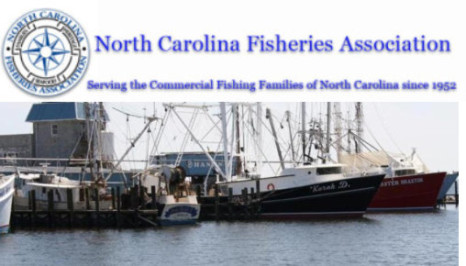
North Carolina Fisheries Association Weekly Update for Februay 6, 2017
Click here to read the Weekly Update, to read all the updates, Click here 20:21
Crabbing: an inherently dangerous job
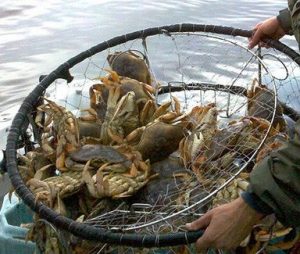 Some may wonder if the 2017 Dungeness crab season was ill-fated: First delayed by weeks to make certain crab were free of domoic acid toxin, delayed again after processors proposed lowering the price paid to crabbers, and then it started with a capsizing near the mouth of the Columbia River that could have cost five lives except for quick intervention by another crabbing boat. Today’s crabbers and fishermen have to be smart and rational to survive — literally and economically. Delays in the season also often have strategic components involving jockeying over price, and competition over crabbing grounds. Sometimes crabbers wait to allow an early-season storm to pass. Read the op-ed here 18:59
Some may wonder if the 2017 Dungeness crab season was ill-fated: First delayed by weeks to make certain crab were free of domoic acid toxin, delayed again after processors proposed lowering the price paid to crabbers, and then it started with a capsizing near the mouth of the Columbia River that could have cost five lives except for quick intervention by another crabbing boat. Today’s crabbers and fishermen have to be smart and rational to survive — literally and economically. Delays in the season also often have strategic components involving jockeying over price, and competition over crabbing grounds. Sometimes crabbers wait to allow an early-season storm to pass. Read the op-ed here 18:59
Factory Boss Says Fishing Technology Could Improve Controversial US Border Wall
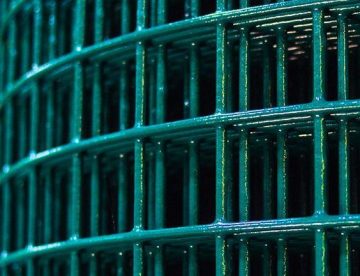 A manufacturing company says skills and technology it developed making lobster traps could help save money on U.S. President Donald Trump’s controversial plan to build a wall along the U.S.-Mexico border. Riverdale Mills’ super-tough steel fence already guards 43 kilometers of the border, and the company says its technology has proven to be a cost-effective way to secure airports, prisons and nuclear facilities. The small firm is based in Northbridge, Massachusetts, and CEO Jim Knott says his company came up with a much better way to make lobster traps. The metal mesh is assembled on huge automated machines that weld many joints at once. The mesh can be made of different sizes of steel, with different size openings for different applications. The mesh is run through a huge vat of molten zinc to protect the product from rust. For lobster traps and other marine applications, the product gets an additional coating of special plant-based plastics that protect the zinc. The plastic formula is a trade secret. Lobster traps have to be sturdy, effective and affordable, and Knott says lessons from making them improved the design and production of mesh for other applications. Read the story here 14:56
A manufacturing company says skills and technology it developed making lobster traps could help save money on U.S. President Donald Trump’s controversial plan to build a wall along the U.S.-Mexico border. Riverdale Mills’ super-tough steel fence already guards 43 kilometers of the border, and the company says its technology has proven to be a cost-effective way to secure airports, prisons and nuclear facilities. The small firm is based in Northbridge, Massachusetts, and CEO Jim Knott says his company came up with a much better way to make lobster traps. The metal mesh is assembled on huge automated machines that weld many joints at once. The mesh can be made of different sizes of steel, with different size openings for different applications. The mesh is run through a huge vat of molten zinc to protect the product from rust. For lobster traps and other marine applications, the product gets an additional coating of special plant-based plastics that protect the zinc. The plastic formula is a trade secret. Lobster traps have to be sturdy, effective and affordable, and Knott says lessons from making them improved the design and production of mesh for other applications. Read the story here 14:56

































